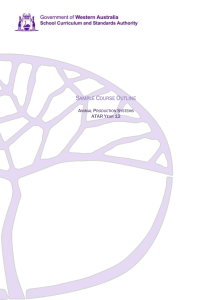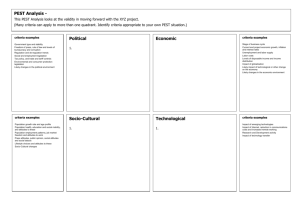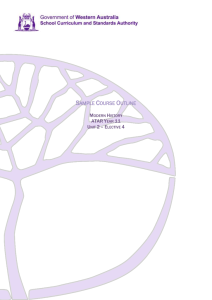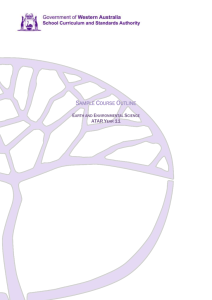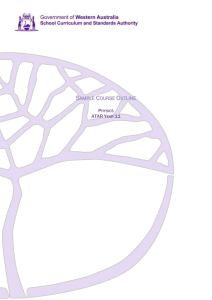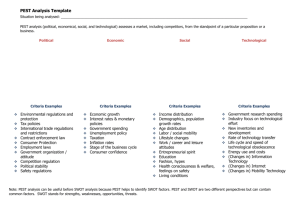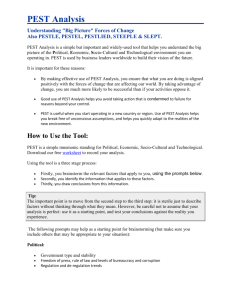Word Format - School Curriculum and Standards Authority
advertisement
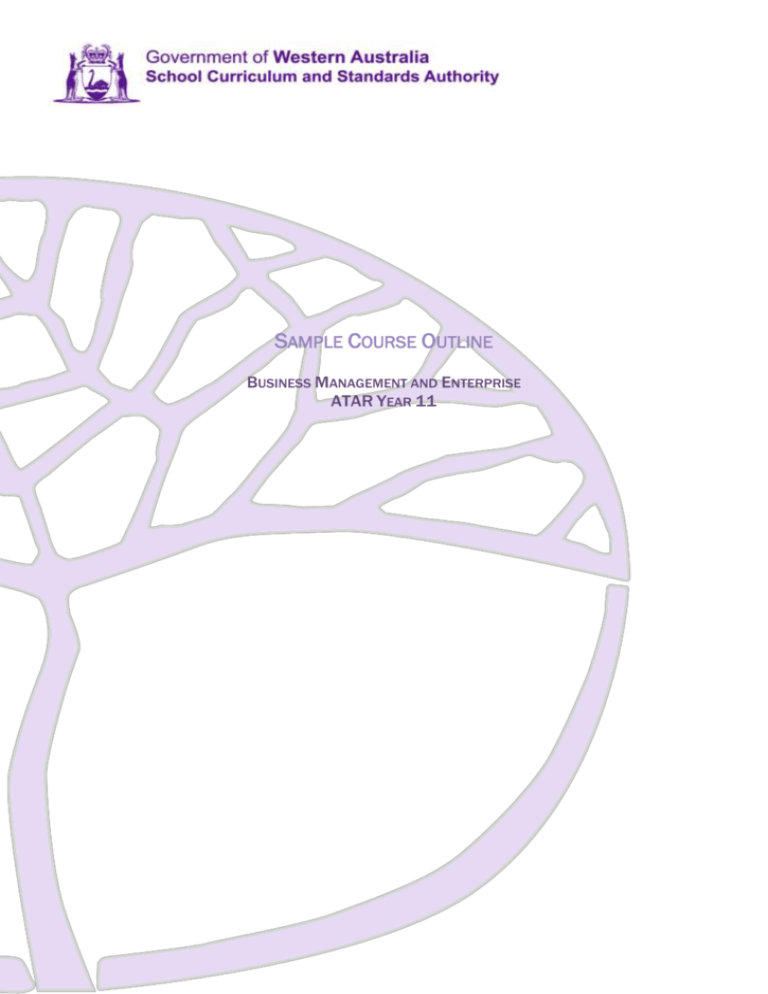
SAMPLE COURSE OUTLINE BUSINESS MANAGEMENT AND ENTERPRISE ATAR YEAR 11 Copyright © School Curriculum and Standards Authority, 2014 This document – apart from any third party copyright material contained in it – may be freely copied, or communicated on an intranet, for non-commercial purposes in educational institutions, provided that the School Curriculum and Standards Authority is acknowledged as the copyright owner, and that the Authority’s moral rights are not infringed. Copying or communication for any other purpose can be done only within the terms of the Copyright Act 1968 or with prior written permission of the School Curriculum and Standards Authority. Copying or communication of any third party copyright material can be done only within the terms of the Copyright Act 1968 or with permission of the copyright owners. Any content in this document that has been derived from the Australian Curriculum may be used under the terms of the Creative Commons Attribution-NonCommercial 3.0 Australia licence Disclaimer Any resources such as texts, websites and so on that may be referred to in this document are provided as examples of resources that teachers can use to support their learning programs. Their inclusion does not imply that they are mandatory or that they are the only resources relevant to the course. 2014/17847v5 1 Sample course outline Business Management and Enterprise – ATAR Year 11 Semester 1 – Unit 1 Week 1–3 4–8 Key teaching points Overview of the syllabus, expectations and assessment outline Environments: Political and legal, economic, socio-cultural and technological (PEST) types of business ownership in small to medium enterprises (SMEs) sole traders partnerships small proprietary companies not-for-profit organisations franchises impact of economic factors on business function, including: inflation interest rates availability of skilled and unskilled labour unemployment rates the concept of business public image methods of raising business public image, including: corporate sponsorship donations positive and negative impacts on business image of environmental issues, including: climate change pollution energy use animal testing Management: Marketing the concepts of market and marketing differences between market size and market share key elements of a marketing plan, including: market position competitor analysis target market analysis marketing goals marketing strategy marketing mix characteristics of market segmentation, including: demographic geographic psychographic (lifestyle and behaviour) key features of the market research process, including: collection of primary and secondary data data analysis the concept of the marketing mix elements of the marketing mix product o positioning o features o branding o packaging Sample course outline | Business Management and Enterprise | ATAR Year 11 2 Week Key teaching points 4–8 9 price o skim o penetration o psychological o premium/prestige place o direct distribution o indirect distribution o location promotion o advertising o publicity o sales promotion o viral marketing o telemarketing people (employees) o training and customer service as part of customer relationship management (CRM) processes o procedures to deliver a service or product physical presence of the business o signage o webpage o staff uniform performance o evaluation of business marketing objectives using key performance indicators (KPIs), including: sales revenue, sales returns and customer satisfaction the use of customer profiling to determine customer needs and expectations the use of competitor profiling to determine competitor product range, prices and marketing strategies the use of technologies to facilitate promotional activities, including: internet mobile devices strategies for managing customer behaviour brand loyalty customer loyalty early adopter incentive Management: Operations levels of management within a business top middle frontline types of organisational structures, including: functional product divisional team features of organisational structures, including: chain of command span of control delegation Sample course outline | Business Management and Enterprise | ATAR Year 11 3 Week 10–11 12–15 16 Key teaching points Environments: Political and legal, economic, socio-cultural and technological (PEST) Australian consumer law in relation to misleading and deceptive conduct in business marketing activity, including: bait advertising scientific claims country of origin consumer rights and protection, including: product safety (Australian Standards) guarantees, warranties and refunds repair and replace Environments: Political and legal, economic, socio-cultural and technological (PEST) national employment standards for employment contracts, including: minimum wage minimum working conditions unfair dismissal key elements of a contract intention agreement (offer and acceptance) consideration legal requirements of contracts, including: capacity consent legal purpose People phases of the employment cycle acquisition o staffing needs o selection and recruitment development o induction o training maintenance o agreements o contracts o performance management separation o retirement o resignation o retrenchment o dismissal Semester 1 examination Sample course outline | Business Management and Enterprise | ATAR Year 11 4 Semester 2 – Unit 2 Week Key teaching points 1–3 Overview of the syllabus, expectations and assessment outline People the concept of motivation in business, including methods of reward, benefits and penalties financial incentives for employees, including: sales bonuses shares schemes non-financial incentives for employees, including: skill improvement training recognition and reward characteristics of the following motivation theories: Maslow’s Hierarchy of Needs Herzberg’s Motivation-Hygiene Theory Vroom’s Expectancy Theory Adams’ Equity Theory key features of the following leadership styles: autocratic participative situational 4–5 Environments: Political and legal, economic, socio-cultural and technological (PEST) factors that influence spending patterns of small to medium sized enterprises (SME) and consumers, including: the level of economic activity prevailing community social norms, including attitudes to business public image and sustainability issues related to the marketing and promotion of the following products: alcohol tobacco fast food 6 7–8 Management: Marketing features and purposes of a marketing strategy stages of the product lifecycle development growth saturation decline applying marketing strategies for each stage of the product lifecycle Environments: Political and legal, economic, socio-cultural and technological (PEST) the concept of intellectual property (IP) purpose of IP laws in Australia types of intellectual property registrations, including: patents domain names trademarks designs process for Australian IP registration Sample course outline | Business Management and Enterprise | ATAR Year 11 5 Week Key teaching points 9–10 Environments: Political and legal, economic, socio-cultural and technological (PEST) influence of government policy on the following: product labelling trading hours advertising practices to children intent and purpose of the Equal Employment Opportunity (EEO) Act 1987 responsibility of an employer within the EEO Act responsibility of an employee within the EEO Act intent and purpose of the Occupational Safety and Health (OSH) Act 1984 (WA) responsibility of an employer within the OSH Act responsibility of an employee within the OSH Act 11–13 Management: Operations purpose and features of the following financial reports: a budget a balance sheet (statement of financial position) a profit and loss statement function of key performance indicators (KPIs) characteristics of the following financial indicators profitability cost reduction sales characteristics of the following non-financial indicators quality customer satisfaction 14–15 Management: Operations purpose and intent of a business plan key elements and structure of a business plan, including: executive summary vision statement mission statement business concept operations strategy marketing plan, including SWOT (strengths, weaknesses, opportunities, threats) analysis financial plan human resource management (HRM) 16 Semester 2 examination Sample course outline | Business Management and Enterprise | ATAR Year 11
